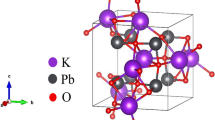Abstract
Despite the order/disorder nature of its ferroelectric phase transition, and evidence for the evolution of local order as being important for understanding the transition, no comprehensive diffuse scattering study of the short-range order in triglycine sulphate, (TGS), (NH2CH2COOH)3H2SO4 has been undertaken. Diffuse scattering from single crystals is sensitive to two-body correlations, and can act as a probe of local structure, which in a second order phase transition acts as a precursor to the low temperature phase. The role of hydrogen bonding and dipolar interactions in the ferroelectric phase transition in TGS has been a long matter of conjecture. Using neutron and X-ray single crystal diffuse scattering this study shows that hydrogen bond mediated interactions between polarising glycine molecules cause local one-dimensional polarised domains to develop, oriented parallel to the b axis. These domains interact via dipolar interactions, and the three-dimensional ferroelectric order arises. This provides a real-space, interaction-based model for the phase transition in TGS, showing in detail how the local chemistry and physics give rise to the polarised state.











Similar content being viewed by others
References
Barabash RI, Ice GE, Turchi PEA (eds) (2009) Diffuse scattering and the fundamental properties of materials, 1st edn. Momentum Press, Highland Park
Chan EJ, Welberry TR, Goossens DJ, Heerdegen AP (2010) J Appl Crystallogr 43:913
Choudhury RR, Chitra R (2008) Pramana J Phys 71:911
Choudhury RR, Chitra R (2009) J Phys Condens Mat 21:335901
Choudhury RR, Chitra R, Ramanadham M (2003) J Phys Condens Mat 15:4641
Choudhury RR, Chitra R, Sastry PU, Das A, Ramanadham M (2004) Pramana J Phys 63:107
Estermann MA, Steurer W (1998) Phase Transit 67:165
Fletcher SR, Keve ET, Skapski AC (1976) Feroelectrics 14:775
Fletcher SR, Keve ET, Skapski AC (1976) Feroelectrics 14:789
Fujii Y, Yamada Y (1971) J Phys Soc Jpn 30:1676
Gonzalo JA (1966) Phys Rev 144:662
Goossens DJ, Gutmann MJ (2009) Phys Rev Lett 102:015,505
Goossens DJ, Heerdegen AP, Chan EJ, Welberry TR (2011) Metall Mater Trans A 42:23
Hoshino S, Okaya Y, Pepinsky R (1959) Phys Rev 115:323
Hudspeth JM, Goossens DJ (2012) J Cryst Growth 338:177
Hudspeth JM, Goossens DJ, Gutmann MJ, Studer AJ (2013) Cryst Res Technol 48(3):169
Jeffrey GA (1997) An introduction to hydrogen bonding. Oxford University Press, New York
Kay MI (1977) Ferroelectrics 17:415
Kay MI, Kleinberg R (1973) Ferroelectrics 5:45
Keen DA, Gutmann MJ, Wilson CC (2006) J Appl Cryst 39:714
Kikuta T, Hamatake D, Tamazaki T, Nakatani N (2007) Ferroelectrics 347:65
Kikuta T, Tamazaki T, Nakatani N (2010) Ferroelectrics 403:111
Lines ME, Glass AM (2001) Principles and applications of ferroelectrics and related materials. Oxford University Press, New York
Neder RB, Proffen T (2008) Diffuse scattering and defect structure simulations. Oxford University Press, New York
Pura B, Przedmojski J (1973) Phys Lett A 43:217
Scheidegger S, Estermann MA, Steurer W (2000) J Appl Cryst 33:35
Schneider CA, Rasband WS, Eliceiri KW (2012) Nat Methods (Oxford, UK) 9:671
Schweika W (1998) Disordered alloys, diffuse scattering and Monte Carlo simulations. Springer, Berlin
Shibuya I, Mitsui T (1961) J Phys Soc Jpn 16:479
Tripadus V, Aranghel D, Statescu M, Buchsteiner A (2008) Chem Phys 353:59
Weber T, Estermann MA, Bürgi HB (2001) Acta Cryst B 57:579
Welberry TR (2004) Diffuse X-ray Scattering and Models of Disorder. Oxford University Press, Oxford
Welberry TR, Goossens DJ, David WIF, Gutmann MJ, Bull MJ, Heerdegen AP (2003) J Appl Cryst 36:1440
Welberry TR, Goossens DJ, Heerdegen AP, Lee PL (2005) Z Krist 220:1052
Acknowledgements
The authors gratefully acknowledge the Australian Institute for Nuclear Science and Engineering, the NCI National Facility and the Australian Research Council. Use of the Advanced Photon Source was supported by the U. S. Department of Energy, Office of Science, Office of Basic Energy Sciences, under Contract No. DE-AC02-06CH11357.
Author information
Authors and Affiliations
Corresponding author
Rights and permissions
About this article
Cite this article
Hudspeth, J.M., Goossens, D.J., Welberry, T.R. et al. Diffuse scattering and the mechanism for the phase transition in triglycine sulphate. J Mater Sci 48, 6605–6612 (2013). https://doi.org/10.1007/s10853-013-7457-8
Received:
Accepted:
Published:
Issue Date:
DOI: https://doi.org/10.1007/s10853-013-7457-8




